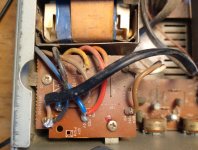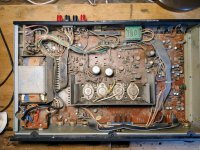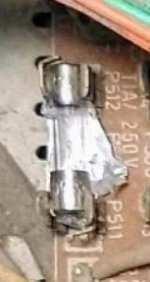Hi,
Owned this amp for 30 years then managed to drop it on the floor today and now no power, completely dead. I'm an idiot
Can anyone advise what I have most likely broken? I will start with the power supply but after that I'm just guessing.
thank you
Owned this amp for 30 years then managed to drop it on the floor today and now no power, completely dead. I'm an idiot

Can anyone advise what I have most likely broken? I will start with the power supply but after that I'm just guessing.
thank you
Put it this way the majority of faults in dropped amplifiers was a cracked PCB that I repaired ,sometimes hard to spot but you are starting in the right place .
You could be lucky. Might only be a connector loose.
You'll have to open it up and check the power supply. there are many threads with the schematic for example this one: NAD 3020 series 20 power issues - Page 4 - diyAudio
Safety note to new repair diys: Voltage over 24 across the heart can stop it. Use only one hand checking voltages with the power on. Alligator clip the negative lead of the DVM to the speaker ground with one hand, then take measurements with one hand.
Don't wear any jewelry on hands arms or neck while repairing. 1 v through a ring can burn your flesh to charcoal if the amperage is high enough.
Wear safety glasses especially unsoldering. Solder can splash. Also defective parts can explode.
I find the DVM from farnell to be reliable. About $25. I don't like the autoranging ones, it always starts at the wrong range, 200 mv, and switches twice before getting to 200 v which is useful. Get clip leads and a fuse or three on the same order to save freight.
First check would be AC coming in through the switch.
Second check would be dc voltage on the big capacitors, the ones that look like oil tanks. Those are the main supply voltages.
Hope it is not a fractured PCB. Those can have many many failture points and require a dozen or more patch jumpers. Not a job for a newby. A donor amp or a replacement is probably economic if you find that problem. I've never had one but I don't own a NAD. In my Peavey products from the 80-s 90-s I have had bad solder joints (that look good) that are vibration, shock, and flexure sensitive. Sometimes they worked, good enough to get through initial QA check anyway.
You'll have to open it up and check the power supply. there are many threads with the schematic for example this one: NAD 3020 series 20 power issues - Page 4 - diyAudio
Safety note to new repair diys: Voltage over 24 across the heart can stop it. Use only one hand checking voltages with the power on. Alligator clip the negative lead of the DVM to the speaker ground with one hand, then take measurements with one hand.
Don't wear any jewelry on hands arms or neck while repairing. 1 v through a ring can burn your flesh to charcoal if the amperage is high enough.
Wear safety glasses especially unsoldering. Solder can splash. Also defective parts can explode.
I find the DVM from farnell to be reliable. About $25. I don't like the autoranging ones, it always starts at the wrong range, 200 mv, and switches twice before getting to 200 v which is useful. Get clip leads and a fuse or three on the same order to save freight.
First check would be AC coming in through the switch.
Second check would be dc voltage on the big capacitors, the ones that look like oil tanks. Those are the main supply voltages.
Hope it is not a fractured PCB. Those can have many many failture points and require a dozen or more patch jumpers. Not a job for a newby. A donor amp or a replacement is probably economic if you find that problem. I've never had one but I don't own a NAD. In my Peavey products from the 80-s 90-s I have had bad solder joints (that look good) that are vibration, shock, and flexure sensitive. Sometimes they worked, good enough to get through initial QA check anyway.
Last edited:
If it's completely dead from a drop, it's probably a power supply issue. Follow the current flow from the power cord to the circuit board through the power transformer and to the main reservoir caps. Those caps will likely be the largest in the amp, so they're easy to find.
Follow the safety advice given above. Keep in mind that you're dealing with lethal voltages in some places.
Carefully measure the voltage going from the power cord/IEC inlet to the reservoir caps. You'll want to measure AC voltage from the power cord to the rectifier (likely the first component connected after the transformer) and DC voltage on the reservoir caps.
If the transformer is mounted on the circuit board itself, you're probably looking at a cracked board or cracked solder joints on the transformer. I'd reflow those (so touch with soldering iron and add a little solder).
Don't start randomly swapping parts or turning trimpots. That's usually the fastest route to disappointment because you a) won't fix the original issue and b) end up breaking something. Always fix, then modify (assuming you even want to modify).
Tom
Follow the safety advice given above. Keep in mind that you're dealing with lethal voltages in some places.
Carefully measure the voltage going from the power cord/IEC inlet to the reservoir caps. You'll want to measure AC voltage from the power cord to the rectifier (likely the first component connected after the transformer) and DC voltage on the reservoir caps.
If the transformer is mounted on the circuit board itself, you're probably looking at a cracked board or cracked solder joints on the transformer. I'd reflow those (so touch with soldering iron and add a little solder).
Don't start randomly swapping parts or turning trimpots. That's usually the fastest route to disappointment because you a) won't fix the original issue and b) end up breaking something. Always fix, then modify (assuming you even want to modify).
Tom
Thank you so much for the replies. Some really good tips and safety advice. Feel fairly confident checking the voltages I’ve done plenty of laptop repair and a few domestic appliances but never audio.
Checked the fuses and looked for anything obvious. I did notice a damaged wire connected to the live AC (first pic, now tapped up), makes me wonder why there’s no earth wire but there was a plastic cover over it.
Looks like there’s been some liquid on the PCB at some point but the AMP was working perfectly until the other day. I’m going to have to start studying those wiring diagrams and watch a few youtube videos!
Thanks again
Checked the fuses and looked for anything obvious. I did notice a damaged wire connected to the live AC (first pic, now tapped up), makes me wonder why there’s no earth wire but there was a plastic cover over it.
Looks like there’s been some liquid on the PCB at some point but the AMP was working perfectly until the other day. I’m going to have to start studying those wiring diagrams and watch a few youtube videos!
Thanks again
Attachments
according to schematic F505 is a 1A Fuse,
schematic
NAD 3020I 3225PE SM Service Manual download, schematics, eeprom, repair info for electronics experts
schematic
NAD 3020I 3225PE SM Service Manual download, schematics, eeprom, repair info for electronics experts
The one in the picture looked to have tinfoil underneath it. I know pictures can be deceiving but that is what it looks like.
Looks like this amp could do with a bristle brush + vacuum cleaner treatment for starters.
I'd say start from the transformer secondary side or main power rails and go from there. If there is nothing even at that point, make sure that 240 V~ (both L and N) make it to the primary at all, maybe it's a busted power switch.
These are IEC Class II devices (double insulated). Construction has to ensure that the mains is kept well-insulated from everything mains.Checked the fuses and looked for anything obvious. I did notice a damaged wire connected to the live AC (first pic, now tapped up), makes me wonder why there’s no earth wire but there was a plastic cover over it.
I'd say start from the transformer secondary side or main power rails and go from there. If there is nothing even at that point, make sure that 240 V~ (both L and N) make it to the primary at all, maybe it's a busted power switch.
*facepalm*Construction has to ensure that the mains is kept well-insulated from everything mains.
Oops. Close but no cigar. 🙄 I obviously meant to say
Construction has to ensure that the mains is kept well-insulated from everything secondary side.
"Looks like this amp could do with a bristle brush + vacuum cleaner treatment for starters." Perhaps, dishwasher 🙂 It's not easy job.
Ha! Funny thing is I've already been over it with the vacuum you should have it before 😱
Probably could haver done a better job didn't want to get too close and cause more damage
Probably could haver done a better job didn't want to get too close and cause more damage
- Home
- Amplifiers
- Solid State
- Nad 3020i no power - Dropped :(


